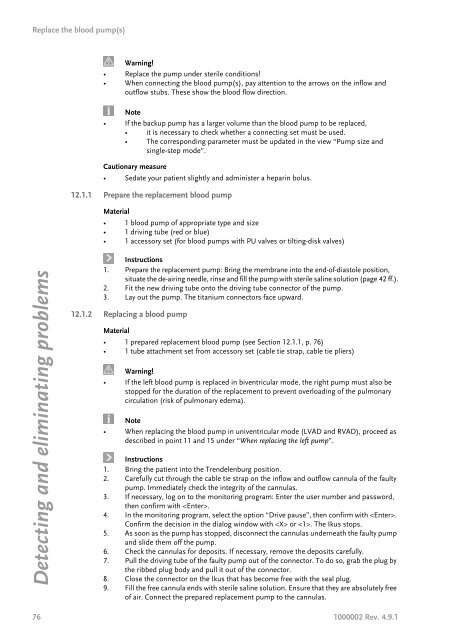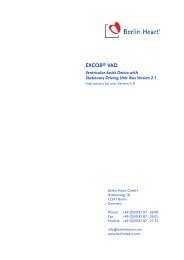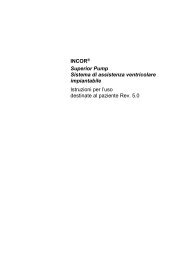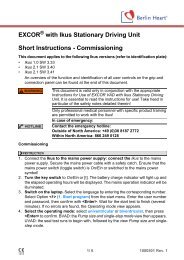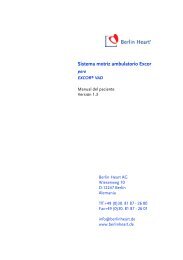Instructions for use: Ikus - Berlin Heart
Instructions for use: Ikus - Berlin Heart
Instructions for use: Ikus - Berlin Heart
Create successful ePaper yourself
Turn your PDF publications into a flip-book with our unique Google optimized e-Paper software.
Replace the blood pump(s)<br />
Detecting and eliminating problems<br />
Warning!<br />
• Replace the pump under sterile conditions!<br />
• When connecting the blood pump(s), pay attention to the arrows on the inflow and<br />
outflow stubs. These show the blood flow direction.<br />
Note<br />
• If the backup pump has a larger volume than the blood pump to be replaced,<br />
• it is necessary to check whether a connecting set must be <strong>use</strong>d.<br />
• The corresponding parameter must be updated in the view “Pump size and<br />
single-step mode”.<br />
Cautionary measure<br />
• Sedate your patient slightly and administer a heparin bolus.<br />
12.1.1 Prepare the replacement blood pump<br />
Material<br />
• 1 blood pump of appropriate type and size<br />
• 1 driving tube (red or blue)<br />
• 1 accessory set (<strong>for</strong> blood pumps with PU valves or tilting-disk valves)<br />
<strong>Instructions</strong><br />
1. Prepare the replacement pump: Bring the membrane into the end-of-diastole position,<br />
situate the de-airing needle, rinse and fill the pump with sterile saline solution (page 42 ff.).<br />
2. Fit the new driving tube onto the driving tube connector of the pump.<br />
3. Lay out the pump. The titanium connectors face upward.<br />
12.1.2 Replacing a blood pump<br />
Material<br />
• 1 prepared replacement blood pump (see Section 12.1.1, p. 76)<br />
• 1 tube attachment set from accessory set (cable tie strap, cable tie pliers)<br />
Warning!<br />
• If the left blood pump is replaced in biventricular mode, the right pump must also be<br />
stopped <strong>for</strong> the duration of the replacement to prevent overloading of the pulmonary<br />
circulation (risk of pulmonary edema).<br />
Note<br />
• When replacing the blood pump in univentricular mode (LVAD and RVAD), proceed as<br />
described in point 11 and 15 under “When replacing the left pump”.<br />
<strong>Instructions</strong><br />
1. Bring the patient into the Trendelenburg position.<br />
2. Carefully cut through the cable tie strap on the inflow and outflow cannula of the faulty<br />
pump. Immediately check the integrity of the cannulas.<br />
3. If necessary, log on to the monitoring program: Enter the <strong>use</strong>r number and password,<br />
then confirm with .<br />
4. In the monitoring program, select the option “Drive pa<strong>use</strong>”, then confirm with .<br />
Confirm the decision in the dialog window with or . The <strong>Ikus</strong> stops.<br />
5. As soon as the pump has stopped, disconnect the cannulas underneath the faulty pump<br />
and slide them off the pump.<br />
6. Check the cannulas <strong>for</strong> deposits. If necessary, remove the deposits carefully.<br />
7. Pull the driving tube of the faulty pump out of the connector. To do so, grab the plug by<br />
the ribbed plug body and pull it out of the connector.<br />
8. Close the connector on the <strong>Ikus</strong> that has become free with the seal plug.<br />
9. Fill the free cannula ends with sterile saline solution. Ensure that they are absolutely free<br />
of air. Connect the prepared replacement pump to the cannulas.<br />
76 1000002 Rev. 4.9.1


